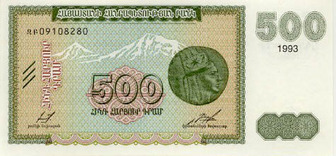The currency name of ARMENIA is the Armenian Dram

The term dram simply means money so over the centuries there have been many forms of currency referred to as the dram. The dram comes in a variety of denominations, and is available in the form of both coins as well as bank notes. The dram is also further subdivided into lumas with 100 luma equally 1 dram.
The first known form of the dram came into history in the year 1199, and lasted into the twilight of Armenian royal rule in 1375. King Leo II ,also known as Levon I, had the dram struck from silver and decorated with a wide variety of symbols. This style of dram persisted for nearly 200 years. This type of the dram disappeared in the late 1300's as the kingship of the country collapsed.
Over the years as the kingdom of Armenia fell into disarray, and the country found would finally find itself under the yoke of Soviet rule, extending from the Czarist era in Russia up into the early 1990's.
In 1991 Armenia declared itself a separate entity from the crumbling Soviet Union and shortly thereafter The Central Bank of Armenia was established. The Central Bank would revive the dram in the form of bank notes ranging in worth from 10 to 500 Drams. By 1996 the bank had also issued notes for up to 5000 drams. As the 1990s became the new millennium the bank issued notes for up to 50,000 drams.
In the early parts of the 2000s new dram coins were struck ranging from 10 to 500 drams. A 10 dram coin was struck in aluminum, and a 200 dram coin was struck from brass, all other denominations are steel plated with copper, nickle, or brass according to worth.
Several industries affect the worth of the dram, the most notable being the agricultural community which is the countries largest employer. It is also affected by trade with the European Union, and Russia as these are the countries two main trading partners. Currently 70,000 drams equal roughly 200 USD which means that one US dollar is worth about 363 drams making it one of the worlds lowest valued denominations.
